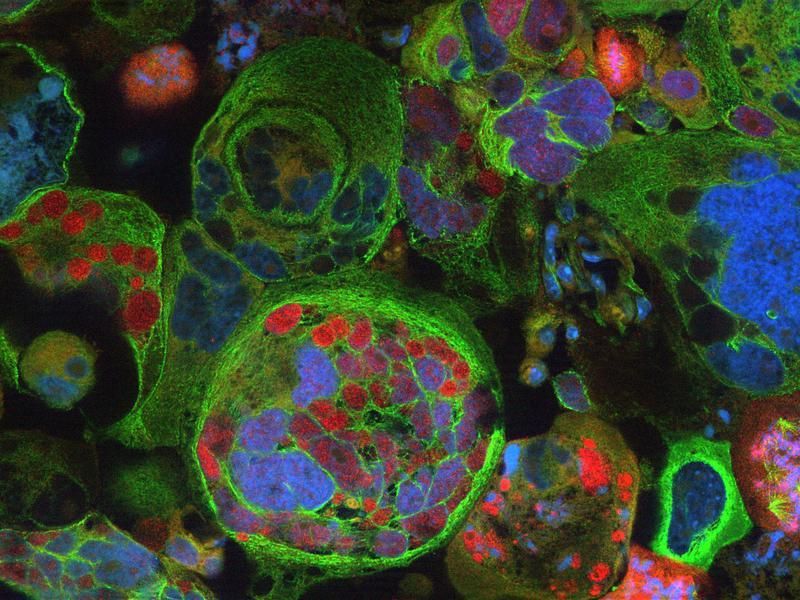Protein highways keep tissues organize
Precise regulation of tissue architecture is critical for organ function. Single cells build up a tissue by communicating with their environment and with other cells, thereby receiving instructions on whether to divide, change shape or migrate. An interdisciplinary group of researchers from several Max Planck Institutes have now identified a mechanism by which skin cells organize their interior architecture as a response to signals from their surroundings. “Cells react to changes in their environment very rapidly. To do this, cells need to have their signaling machinery at the right place at the right time” says Sara Wickström, a researcher from the Max Planck Institute of biochemistry.

Proteins (in red) are transported along a intracellular highway (microtubules, in green) to the cell periphery.
Sara Wickstroem / Copyright: MPI of Biochemistry
Cellular behavior is controlled by signaling pathways which deliver information derived from the surrounding tissue and other cells to the nucleus and other parts of the cell. In order to achieve both efficient and tightly regulated signaling, cells organize their proteins into distinct cellular compartments. This organization is carried out by intracellular highways called microtubules that are specialized in protein transport. Sara Wickström from the MPIB is analyzing how signals from the extracellular environment regulate these intracellular highways to allow the transport of specific proteins to their correct location. Genetic analyses in mouse skin revealed that signaling from integrins, cell surface receptors that mediate the interactions of cells with their environment, regulate the organization of microtubules so that they can efficiently deliver proteins the cell surface. This is particularly important in tissues like skin, where the upper surfaces of the cells facing the outside world require a different composition than the lower surface facing the interior of the organism.
In collaboration with Matthias Mann and the Department of Proteomics and Signal Transduction, the exact proteins involved in the process were identified. In addition, expertise provided by Joachim P. Spatz at the MPI of Metals Research in Stuttgart allowed investigating the role of the cell shape in the regulation of microtubules. “The process of protein transport is very complex, and therefore a wide range of different approaches were needed to analyze it”, says Sara Wickström.
During diseases like cancer, cells escape normal regulatory mechanisms of cell adhesion and growth signaling to become more motile and proliferative. Changes in the levels of adhesion receptors as well as in the overall protein composition and distribution at the cell surface have long been known to take place in tumor cells. “The most interesting finding of our study is that all these processes are interregulated. Therefore understanding the basic mechanisms of the regulation might help to tackle the primary causes of these changes during disease”, says Sara Wickström. A particularly interesting question is why diseases like cancer become more frequent during ageing, during which structural alterations in the tissues also occur. Sara Wickström will move to start her own research group at the Max Planck Institute for Biology of Ageing in Cologne to continue this interesting avenue of research.
Original Publication: S. A. Wickström, A. Lange, M. W. Hess, J. Polleux, J. P. Spatz, M. Krüger, K. Pfaller, A. Lambacher, W. Bloch, M. Mann, L. A. Huber and R. Fässler; "Integrin-linked kinase controls microtubule dynamics required for plasma membrane targeting of caveolae"; Developmental Cell, October 19, 2010
Other news from the department science

Get the life science industry in your inbox
By submitting this form you agree that LUMITOS AG will send you the newsletter(s) selected above by email. Your data will not be passed on to third parties. Your data will be stored and processed in accordance with our data protection regulations. LUMITOS may contact you by email for the purpose of advertising or market and opinion surveys. You can revoke your consent at any time without giving reasons to LUMITOS AG, Ernst-Augustin-Str. 2, 12489 Berlin, Germany or by e-mail at revoke@lumitos.com with effect for the future. In addition, each email contains a link to unsubscribe from the corresponding newsletter.
Most read news
More news from our other portals
Last viewed contents

Gene identified that could help prevent or delay onset of Alzheimer's disease - Boosting ABCC1 could lessen the production of plaque linked to Alzheimer's development






















































